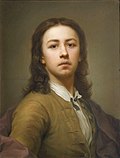Infante Francisco Javier of Spain, Date of Birth, Place of Birth, Date of Death
TweetInfante Francisco Javier of Spain
Spanish infanteAbout Infante Francisco Javier of Spain
- Charles III (Spanish: Carlos; Italian: Carlo; 20 January 1716 – 14 December 1788) was King of Spain (1759–1788), after ruling Naples as Charles VII and Sicily as Charles V (1734–1759).
- He was the fifth son of Philip V of Spain, and the eldest son of Philip's second wife, Elisabeth Farnese.
- A proponent of enlightened absolutism, he succeeded to the Spanish throne on 10 August 1759, upon the death of his half-brother Ferdinand VI, who left no heirs. In 1731, the 15-year-old Charles became the Duke of Parma and Piacenza, as Charles I, following the death of his childless grand-uncle Antonio Farnese.
- In 1738 he married Princess Maria Amalia of Saxony, daughter of Augustus III of Poland and an educated, cultured woman who gave birth to 13 children, eight of whom reached adulthood.
- Charles and Maria Amalia resided in Naples for 19 years.
- As King of Spain, Charles III made far-reaching reforms such as promoting science and university research, facilitating trade and commerce, and modernising agriculture.
- He also tried to reduce the influence of the Church and strengthen the Spanish army and navy.
- His previous experience as King of Naples and Sicily proved valuable.
- He did not achieve complete control over Spain's finances, and was sometimes obliged to borrow to meet expenses, but most of his reforms proved to be successful and his legacy lives on to this day.Historian Stanley Payne wrote that Charles III "was probably the most successful European ruler of his generation.
- He had provided firm, consistent, intelligent leadership.
- He had chosen capable ministers....[his] personal life had won the respect of the people."
Read more at Wikipedia


 Date of Birth:
Date of Birth:  Place of Birth: Portici, Campania, Italy
Place of Birth: Portici, Campania, Italy
